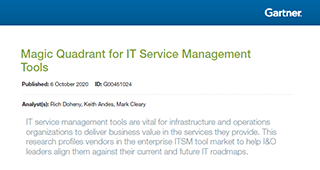Customer expectations have been on the rise for some time now. This is a result of many factors, primary of which is the massive advancements that have been made in the technology sector. Modern customers are keenly aware of how powerful today’s technology is and they expect organizations to leverage that power to provide them with the utmost in quality service and products.
This means that companies need to rise to the challenge of meeting these heightened expectations or risk falling by the wayside as their competition pushes ahead. For IT organizations, the need to constantly evolve and improve upon their offerings is even more necessary. This reality gave rise to the utilization of business management methods such as Agile, Lean, and DevOps.
Leveraging modern business best practices and methodologies allows IT organizations to maintain a rapid speed of development that keeps up with customer demand. However, speed can only get an organization so far without the added component of quality. This is where Total Quality Management can help to fill in the gaps and aid organizations in maintaining a grip on quality while pushing their speed throttle to the max.
What is Total Quality Management?
Total Quality Management (TQM) is a management approach that seeks to provide long-term success by providing unparalleled customer satisfaction through the constant delivery of quality IT services. To properly execute on TQM methods, the entire organization needs to operate as a single unit in the pursuit of excellence. Achieving this is accomplished with a laser-focus on the principles of TQM:
- Customer First – TQM’s first and foremost pillar of success is an unwavering focus on the customer’s experience in all interactions with the organization. From first contact through purchase and continued support, the customer should always be the main priority.
- Employee Ownership – TQM requires the involvement of every team member to ensure that complete quality control is offered at every level. TQM doesn’t focus on a single department because the goal is to provide customers with a great experience from every level of the organization.
- Process-Based – TQM focuses on the creation and implementation of processes that provide organizations with the ability to find success and repeat it. Quantifying success and defining the steps taken to get there are essential for successful implementation of TQM.
- System Integration – TQM strategies revolve around leveraging every asset available to the company. This is best achieved through system integrations that combine disparate parts of the organization into a single, well-oiled machine working in complete synergy.
- Communication – TQM requires every team member to be at their best and to function as a value-adding member of that team. This means communication and transparency is a core tenet of successful TQM practices.
- Data Driven – TQM doesn’t employ guesswork. Instead, data is leveraged for the improvement of the organization and decisions are made based on quantifiable facts.
- Constant Improvement – TQM isn’t a one and done process. Perfection is impossible, so it must always be pursued to get the organization as close as possible to it.
These pillars of TQM act as a framework for every decision made within the methodology. If the organization ever feels lost, these ideals are their guiding stars for righting its course. Implementation of TQM involves making company-wide changes for how work is done.
How to Implement TQM?
The first step for implementing any new system is an honest assessment of the organization as it is today. Implementation of TQM is something that has to be applied to the current structure of the organization and there is no step-by-step guide that will tell you how to do it for your business. Each business is unique and requires its own approach, but the core tenets of TQM can guide each decision.
Creating an emphasis on customer satisfaction will change the way departments think about their duties. If something they are doing isn’t aiding in the improvement of the quality of the product or increasing the customer’s experience, they aren’t headed in the right direction. Each employee should take ownership of their role and be ready to consider ways in which they can improve their own department and outputs.
Communication throughout the organization is essential for educating everyone about the changes that are coming while also providing an avenue for receiving feedback. As they say, communication is a two-way street. Employees will have a much easier time establishing a feeling of ownership over the process when they know their voice is heard and they had a hand in guiding the changes.
One of the most important aspects of delivering quality is managing errors. No matter how focused everyone is on driving quality, IT organizations will always run into one issue or another. Creating processes that mitigate issues is essential for TQM success. Errors should be addressed and dealt with as quickly as possible of course, but they should also be recorded and tracked.
Recurrent issues could be indicative of a deeper issue, requiring large-scale changes to current procedures. An error is an opportunity to assess a problem, but it’s also a chance to discover what is working. Total quality management practitioners should take advantage of errors as a chance to learn from their mistakes and find ways to avoid them in the future.
TQM requires that all parties take ownership of the part they play and this applies equally to admitting fault and giving out praise. A focus on improving the quality of products and services requires accountability. Learning to snatch victory from the jaws of defeat is the pursuit of quality management when it comes to dealing with incidents and outages.
Tracking metrics and comparing the results of operations before and after changes is the best way to learn what works and what doesn’t. It’s also imperative that systems are structured and followed to ensure that success can be replicated and then improved. The process of improvement should never stagnate, ensuring that the pursuit of perfection never ends.







